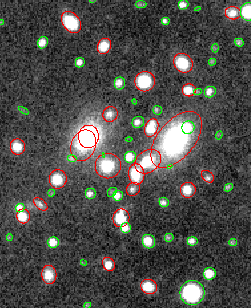Position Intensity and Shape Analysis
Welcome to the PISA home page. This document serves as a place to find
out about the current status of PISA.
What is PISA?
PISA is a group of programs for automatically detecting and measuring
objects on an astronomical image. It also provides the ability to display
the shapes and positions of the detected objects over the image and
convert its results into catalogues.
Current status
For a list of bugs and fixes in the current PISA see the news file in the latest EAO release.
Note that PISA should now be replaced by the
EXTRACTOR package. New users
are encouraged to use EXTRACTOR and old ones to switch.
Documentation

A hypertext form of the
PISA demonstration script is available. You can see this
in action interactively by issuing the commands:
% pisa
% pisa_demo
if you have PISA installed on your system. It's best to do this in an
empty directory as some files are created -- just delete this
afterwards.
A hypertext version of the PISA glossy
brochure is also available.
Problems and limitations
The PISA package has various in-built limitations (buffer sizes etc.),
that are main cause of most of the "bugs" that people complain about. Have
a look at these and if the problem cannot be fixed by applying an
appreciation of its cause get in touch with me. I have an
experimental version of PISAFIND that uses INTEGER images to get
around the 32K limitation. Note that I have no time allocated to this
particular project, so any support you get will be very limited.
-
PISAFIND
- The number of fragments per image (i.e. connected pixel groups)
is limited to 200. Hence blends of objects cannot fragment into more
than 200 pieces.
- The number of pixels per image allowed during surface modelling
is 10000.
- The length of the first side of input image cannot be more than
10240 pixels.
- The input data is processed using an HDS type of _WORD so the
input data range must lie within the bounds -32768 to +32767,
although PISAFIND itself only processes positive data up to the
value 32766. This limitation is fundamental.
-
PISAFIT
- As in PISAFIND the length of first side of the input image has
to be less than 10240 pixels.
- The input data is processed using an HDS type of _WORD so the
input data range must lie within the bounds -32768 to +32767.
Obtaining a copy of PISA
PISA is part of the EAO Starlink release.
|